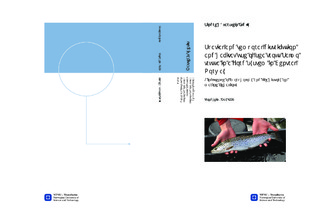| dc.description.abstract | Marine migration and habitat use of sea trout Salmo trutta from the watercourse Søa and the river Snilldalselva in Sør-Trøndelag in Central Norway was studied during summer in 2012 and 2013. Fishes were tagged with acoustic transmitters and their movements and behaviour recorded by automatic listening stations. Significant individual variation in the time spent in the marine environment was found, ranging from 7 days to 183 days during the months from April to September. The spatial distribution in the fjord system varied greatly between the tagged fishes. The innermost parts of the fjords near the tagging watercourses were particularly important areas for the tagged fishes. Both fish from Søa and Snilldalselva had significantly longer residence time in the inner areas compared other parts of the fjord system. Average swimming depth in the period from April to September (1.87 m) turned out to vary significantly between habitats. In littoral (2.11 m) and cliff habitats (2.53 m) the average swimming depth was significantly deeper than in pelagic areas (1.26 m), suggesting differences in prey selection or anti-predator behaviour between the various habitats. The average swimming depth was furthermore significantly deeper during day (1.98 m) than night (1.28 m). The sea trout had a progressively deeper swimming pattern from April towards late summer, positively correlating with water temperature, suggesting that the sea trout actively regulated its internal body temperature. While some individuals remained close to tagging watercourse (< 4 km) throughout the summer, other individuals migrated far out (> 16 km) in the fjord system. Large individuals (> 450 mm) seemed to be more likely to conduct long distance migrations than remaining in inner areas. Long distance migrants furthermore had poorer body condition in spring prior to migration, were found to have greater length at smoltification, and tended to be older and more experienced migrants. Long distance migrants seemed to use pelagic areas more than short distance migrants and tended to maintain pelagic swimming behaviour even when recorded in littoral habitat, suggesting that the migration distance might be linked to feeding behaviour. Furthermore, the observed differences in morphological characteristics and life history indicate, as suggested by previous studies, that the marine behaviour might be a continuum of a conditional strategy in partial migrating sea trout populations, affecting whether the sea trout remain in the innermost parts of the fjord, or migrate far out in the marine system. This implies that the marine behaviour of sea trout might be altered if the conditions in the marine environment change. Furthermore, variation in the marine environment might thus have great impact on an individual s growth and survival, and potentially alter the recruitment and population structure of sea trout stocks. In terms of conservation, the present study illustrates the importance of mapping the marine behaviour of sea trout, as the threats depends heavily on the marine areas it utilises. Gathering of long term data sets on marine environmental conditions, as well as more research on the underlying causes determining the wide range of the sea trout s marine behaviour is advocated, as it might prove to be essential for evaluating and modelling sea trout distribution, behaviour and main threats, and for identifying necessary conservation measures for Norwegian sea trout stocks. | nb_NO |

